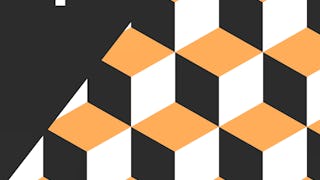Als Änderungsraten geben uns Ableitungen Informationen über die Form eines Graphen. In diesem Kurs werden wir die Ableitung anwenden, um lineare Näherungen für Funktionen mit einer oder mehreren Variablen zu finden. Auf diese Weise können wir auf einfache Weise Funktionen schätzen, die kompliziert oder schwierig zu bewerten sind. Wir werden die Ableitung auch verwenden, um die Maximal- und Minimalwerte einer Funktion zu bestimmen. Diese Optimierungstechniken sind für alle Bereiche wichtig, auch für die Naturwissenschaften und die Datenanalyse. Die Themen dieses Kurses eignen sich für viele reale Anwendungen, wie maschinelles Lernen, Kostenminimierung oder Gewinnmaximierung.

Genießen Sie unbegrenztes Wachstum mit einem Jahr Coursera Plus für 199 $ (regulär 399 $). Jetzt sparen.

Rechnen durch Daten & Modellierung: Anwendung der Differenzierung
Dieser Kurs ist Teil von Spezialisierung für Differentialberechnung durch Daten und Modellierung

Dozent: Joseph W. Cutrone, PhD
TOP-LEHRKRAFT
3.788 bereits angemeldet
Bei enthalten
(59 Bewertungen)
Kompetenzen, die Sie erwerben
- Kategorie: Derivate
- Kategorie: Algebra
- Kategorie: Angewandte Mathematik
- Kategorie: Mathematische Modellierung
- Kategorie: Technische Berechnungen
- Kategorie: Numerische Analyse
- Kategorie: Schätzung
- Kategorie: Infinitesimalrechnung
- Kategorie: Operations Research
Wichtige Details

Zu Ihrem LinkedIn-Profil hinzufügen
Erfahren Sie, wie Mitarbeiter führender Unternehmen gefragte Kompetenzen erwerben.

Erweitern Sie Ihre Fachkenntnisse
- Lernen Sie neue Konzepte von Branchenexperten
- Gewinnen Sie ein Grundverständnis bestimmter Themen oder Tools
- Erwerben Sie berufsrelevante Kompetenzen durch praktische Projekte
- Erwerben Sie ein Berufszertifikat zur Vorlage

In diesem Kurs gibt es 5 Module
In der Einvariablenrechnung berechnet die Ableitung die Steigung der Tangente an der definierten Stelle. Diese wird dann verwendet, um die Gleichung der Tangente an einem Punkt zu erstellen, die als genaues Schätzungsinstrument für komplizierte Funktionen verwendet werden kann. Diese Theorie lässt sich auf Linien im Raum verallgemeinern, die zur Erstellung von Tangentialebenen verwendet werden. In diesem Modul arbeiten wir uns durch die Formeln und Anwendungen dieser Begriffe, indem wir unsere entwickelte Theorie der Ableitungen und partiellen Ableitungen verwenden.
Das ist alles enthalten
2 Videos2 Lektüren1 Aufgabe
Einige der wichtigsten Anwendungen der Differentialrechnung sind Optimierungsprobleme, bei denen das Ziel darin besteht, die optimale (beste) Lösung zu finden. Zum Beispiel geht es bei Problemen im Marketing, in der Wirtschaft, bei der Bestandsanalyse, beim maschinellen Lernen und im Geschäftsleben darum, die beste Lösung zu finden. Diese Probleme lassen sich auf die Suche nach den Maximal- oder Minimalwerten einer Funktion reduzieren, indem wir unsere Vorstellungen von der Ableitung verwenden.
Das ist alles enthalten
2 Videos2 Lektüren1 Aufgabe
Je komplizierter die Modelle werden, desto komplizierter werden auch die Funktionen, mit denen sie beschrieben werden. Viele Funktionen benötigen mehr als eine Eingabe, um ihre Ausgabe zu beschreiben. Diese multivariablen Funktionen enthalten auch Maximal- und Minimalwerte, die wir mit den Werkzeugen der Infinitesimalrechnung zu finden versuchen. In diesem Modul werden wir unsere Optimierungstechniken auf multivariable Funktionen ausweiten.
Das ist alles enthalten
1 Video2 Lektüren1 Aufgabe
In der mathematischen Optimierung ist die Methode der Lagrange-Multiplikatoren eine Strategie, um die lokalen Maxima und Minima einer Funktion zu finden, die Gleichheitsbedingungen unterworfen ist. Sie ist nach dem Mathematiker Joseph-Louis Lagrange benannt. In diesem Modul entwickeln wir die Theorie und arbeiten Beispiele dieses leistungsstarken Werkzeugs durch, das ein eingeschränktes Problem in eine Form umwandelt, bei der der Ableitungstest eines nicht eingeschränkten Problems weiterhin angewendet werden kann. Die Beziehung zwischen dem Gradienten der Funktion und den Gradienten der Nebenbedingungen führt ganz natürlich zu einer meist einfacheren Umformulierung des ursprünglichen Problems.
Das ist alles enthalten
1 Video2 Lektüren1 Aufgabe
Jetzt wenden wir all unsere Theorie und Praxis auf ein reales Problem an, um die Kosten eines Bauprojekts zu modellieren und so den bestmöglichen Preis zu finden. Dieses Projekt ist eine Herausforderung und die Antworten können je nach den von Ihnen verwendeten Annahmen leicht variieren. Gehen Sie in Ihrem Bericht sorgfältig und klar auf die Annahmen ein, die Sie dabei treffen.
Das ist alles enthalten
1 peer review
Erwerben Sie ein Karrierezertifikat.
Fügen Sie dieses Zeugnis Ihrem LinkedIn-Profil, Lebenslauf oder CV hinzu. Teilen Sie sie in Social Media und in Ihrer Leistungsbeurteilung.
Dozent

Mehr von Mathematik und Logik entdecken
 Status: Kostenloser Testzeitraum
Status: Kostenloser TestzeitraumJohns Hopkins University
 Status: Kostenloser Testzeitraum
Status: Kostenloser TestzeitraumJohns Hopkins University
 Status: Vorschau
Status: VorschauPolitecnico di Milano
Warum entscheiden sich Menschen für Coursera für ihre Karriere?




Bewertungen von Lernenden
59 Bewertungen
- 5 stars
79,66 %
- 4 stars
13,55 %
- 3 stars
5,08 %
- 2 stars
1,69 %
- 1 star
0 %
Zeigt 3 von 59 an
Geprüft am 12. Okt. 2025
great journey of real understanding and application based learning
Geprüft am 26. Apr. 2022
Excellent course, very challenging and therefore rewarding when you get the answers right. The feedback is great for self-correction when you go wrong.
Geprüft am 3. Jan. 2023
Excellent though difficult introduction to using differentiation for modeling.
Häufig gestellte Fragen
Um Zugang zu den Kursmaterialien und Aufgaben zu erhalten und um ein Zertifikat zu erwerben, müssen Sie die Zertifikatserfahrung erwerben, wenn Sie sich für einen Kurs anmelden. Sie können stattdessen eine kostenlose Testversion ausprobieren oder finanzielle Unterstützung beantragen. Der Kurs kann stattdessen die Option "Vollständiger Kurs, kein Zertifikat" anbieten. Mit dieser Option können Sie alle Kursmaterialien einsehen, die erforderlichen Bewertungen abgeben und eine Abschlussnote erhalten. Dies bedeutet auch, dass Sie kein Zertifikat erwerben können.
Wenn Sie sich für den Kurs einschreiben, erhalten Sie Zugang zu allen Kursen der Spezialisierung, und Sie erhalten ein Zertifikat, wenn Sie die Arbeit abgeschlossen haben. Ihr elektronisches Zertifikat wird Ihrer Seite "Leistungen" hinzugefügt - von dort aus können Sie Ihr Zertifikat ausdrucken oder Ihrem LinkedIn-Profil hinzufügen.
Ja. Für ausgewählte Lernprogramme können Sie eine finanzielle Unterstützung oder ein Stipendium beantragen, wenn Sie die Anmeldungsgebühr nicht aufbringen können. Wenn für das von Ihnen gewählte Lernprogramm eine finanzielle Unterstützung oder ein Stipendium verfügbar ist, finden Sie auf der Beschreibungsseite einen Link zur Beantragung.
Weitere Fragen
Finanzielle Unterstützung verfügbar,
¹ Einige Aufgaben in diesem Kurs werden mit AI bewertet. Für diese Aufgaben werden Ihre Daten in Übereinstimmung mit Datenschutzhinweis von Courseraverwendet.






